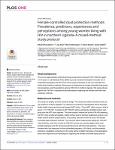Female-controlled dual protection methods: Prevalence, predictors, experiences and perceptions among young women living with HIV in northern Uganda–A mixed-method study protocol
Date
2023Author
Kumakech, Edward
Acen, Joy
Musinguzi, Marvin
Ebong, Doryn
Okello, James
Metadata
Show full item recordAbstract
Study background
The use of dual protection methods among young women living with HIV (YWLHIV) aged
15–24 years in sub-Saharan Africa (SSA) is poorly researched despite the double risk of
unintended pregnancy and HIV. Even more scanty is literature on the use of female-controlled dual protection methods. We propose to determine the female-controlled dual protection prevalence, and the predictors among YWLHIV in northern Uganda. The study will also
explore the YWLHIV’s experiences and perceptions regarding the female-controlled dual
protection methods.
Materials and methods
This study will employ a mixed-methods design. The study area will be Lira district and Lira
city located in northern Uganda. The setting for recruitment of participants will be the public
health facility–based anti-retroviral therapy (ART) clinics. These ART clinics serves a total of
about 1,771 YWLHIV. A sample of 425 YWLHIV will be selected by stratified random sampling from the ART clinic registers. The three strata of interest will be the YWLHIV attending
the ART clinic at referral hospitals, health centers level IV (primary healthcare centers), and
health centers level III (dispensaries). The primary outcome will be the use of the femalecontrolled dual protection methods. The outcome will be measured by asking the YWLHIV
‘what methods under their control as YWLHIV do they use to protect against both unintended pregnancy and HIV during sexual intercourse with their male partners.’ The questionnaire also has measures for the unintended pregnancy, HIV status, and the potential
predictors. Qualitative component of the study will be in-depth interviews of the participants
about their experiences and perceptions regarding the female-controlled dual protection. methods. Data collection was still ongoing at the time of first submission of this study protocol to the journal (14th March 2023). The Statistical Package for Social Sciences (SPSS)
version 23.0 will be used for the statistical analyses. Descriptive statistics, bivariate and multivariate regression analyses will be used to establish the prevalence, associated factors
and the predictors of the outcome respectively. The statistical significance level of 5% and
95% confidence interval will be considered. In-depth interviews will be manually analyzed
using a thematic analysis approach for codes, themes, and categories.
URI
https://doi.org/10.1371/journal. pone.0290338http://ir.lirauni.ac.ug/xmlui/handle/123456789/760
Collections
- Research Articles [36]

